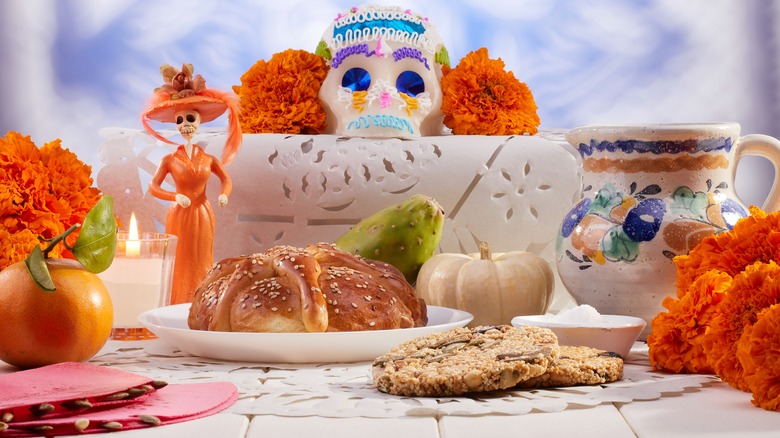What Is An Ofrenda, A Key Component Of Day Of The Dead Celebrations?
The Mexican holiday el Día de los Muertos, or The Day of the Dead, is celebrated between October 31 and November 2, according to History. Per tradition, the souls of the dead return to the earth for a brief visit to reunite with their friends and family. The holiday's roots date back over 3,000 years to the pre-Columbian region of Mesoamerica, comprised of North America and Central America, per the National Hispanic Cultural Center. Nahua people believed the souls of the dead undertook a long journey via nine difficult levels through Chicunamictlán, or the Land of the Dead, to reach Mictlán, the final resting place. The families of the deceased would provide water, food, and tools to aid their loved ones in the course of their travels.
Across the pond, pagan European traditions were folded into the Roman Catholic holiday of All Saints' Day, established in the seventh century to honor Catholic saints and martyrs. In the 11th century, Pope Urban II established All Souls Day on November 2 to honor the dead who were baptized as Christians.
Following the Spanish conquest of Mesoamerica, many people were forcibly converted to Catholicism, according to Berkley Center, and Roman Catholicism remains the most popular religion in modern Mexico, with 72 percent of respondents claiming affiliation in 2020 (via Statista). The combination of centuries-old traditions with the new-to-the-area religion resulted in many customs of today's el Día de los Muertos.
The rich symbolism of ofrendas
Today, people celebrate el Día de los Muertos by going to cemeteries to leave food and offerings on their loved ones' graves and leave ofrenda, or offerings, on an altar in their homes or in their communities. In addition to food and drink, as explained by the university library of CalPolyPomona, there are several other traditional components to the ofrenda, all with symbolic meanings.
Candles represent the element of fire and serve to light the dead souls' paths as they travel in Chicunamictlán. The earth element is represented by food to nourish dead family members' souls and traditionally includes fruit, mole, and chocolate. Water is often represented via fruit punch meant to refresh the spirits along their way while colorful paper flags known as papal picado represent mourning, celebration, hope, and the sun via their colors — as well as the element of wind, blowing to let mourners know their loved ones' spirits have arrived. Marigolds, or cempasuchitl, are the traditional flower found on the altars, which represent life's fleeting nature while their scent is thought to encourage spirits to return.
Colorfully decorated sugar skulls, pan de muerto (or bread of the dead, which is traditionally topped with a skull and crossbones), salt for purification and seasoning of the food offerings, and photographs of the deceased are also all found on the altars, along with Christian iconography such as crucifixes and Virgin Mary statues and favorite knick-knacks or toys of the deceased.
A once local holiday's popularity spreads far and wide
Per History, the Day of the Dead was most popular in rural, indigenous parts of Mexico until the 1980s, at which point celebrations began extending into cities. In 2008, the United Nations Educational, Scientific, and Cultural Organization, or UNESCO, added el Día de los Muertos to its Representative List of the Intangible Cultural Heritage of Humanity as an "Indigenous festivity dedicated to the dead." UNESCO notes that the celebration is important to communities not only to honor the dead via the items placed on the altar or ofrenda, but also to encourage prosperity within communities, as it's believed that the dead will react poorly if they are not honored properly and bring bad luck via illness, accidents, and/or a poor harvest. The Day of the Dead also coincides with the end of corn, or maize, season, which ancient civilizations developed as a crop and continues on as one of the country's most important crops today, per AgriFarming.
Today, the Day of the Dead continues to grow in popularity in Mexico as well as the United States, where over 36 million people claimed Mexican ancestry in the 2016 national census. Mexico City held its first Day of the Dead parade in 2016 and in 2017, many American cities followed suit, including Chicago, Los Angeles, San Antonio, Texas, and Fort Lauderdale, Florida.


